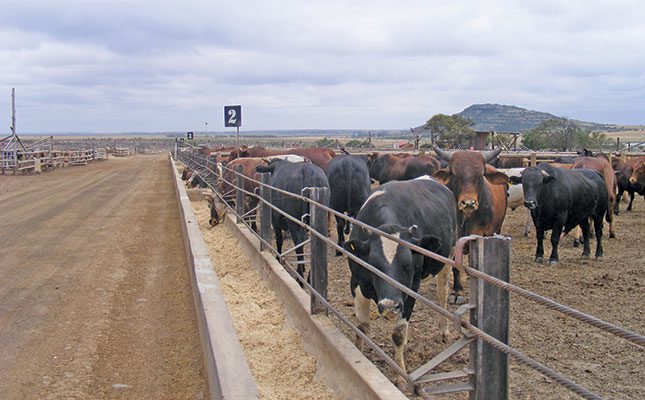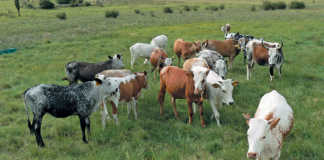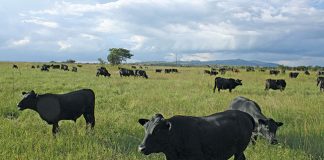
Photo: Sparta Beef
The age of weaners earmarked for a feedlot is one of the most decisive selection criteria for the industry, according to Lynette van Rooyen, group director at Sparta Beef, a feedlotting and beef-processing company in Benoni, Gauteng.
Only weaners of between the ages of five and seven months are accepted, she says, as weaners of that age adapt to feedlot conditions more easily.
The weight of the animal is also important. A calf must weigh a minimum of 180kg, preferably more, at weaning, as heavier calves are stronger and therefore adapt better to a new environment.
In addition, young cattle have better feed conversion ratios, while older animals are more likely to deposit a higher percentage of fat compared with muscle growth.
Feedlots prefer these calves
According to Van Rooyen, the South African beef market mostly prefers Class A beef products, also colloquially referred to as A-grade.
The class is determined by the age of the animal, and age in turn is indicated by the number of permanent incisors that the animal has. If the animal still has all its milk teeth, it’s considered Class A, while one with one of two permanent incisors is AB, three to four permanent incisors is B, and five or more, C.
There is a price difference between the classes. As the animal grows older, price per kilogram decreases.
The class system is often used as an indicator of beef quality. But Charles Mathewson, Sparta’s head of cattle procurement, points out that this is a misconception, as class refers only to the age of the animal.
All Class A carcasses are not equal, however; the quality of the calves, the way they are cared for and fed, and the slaughter process are all very important aspects in determining the quality of the beef.
Steers perform better than heifers in a feedlot as they have a better feed conversion rate than heifers. (The feed conversion rate refers to the kilograms of feed the animal consumes to produce 1kg of live weight over a certain period.)
Heifers reach sexual maturity earlier than bull calves and fat deposition therefore starts earlier. When fat deposition increases, the rate of muscle accretion decreases. It also takes more kilograms of feed to add 1kg of fat than 1kg of muscle (meat).
“The ideal weaner has a big frame that allows ample space for muscle deposition,” explains Van Rooyen. “A long back and a big rump/buttock area means there’s more space to put muscle on where the high-value cuts like sirloin, fillet and rump are situated.
“The health of the calf also plays an important part when we evaluate them. A healthy animal will always have an advantage over a stunted, obviously unwell calf.
“Castrated animals don’t perform as well as uncastrated animals, as bulls have a better capacity to convert feed to muscle.”
More selection crieria
Feedlots also prefer a weaner to be in a so-called ‘dry condition’ upon arrival. (A ‘dry’ calf has been weaned and is already adapted to dry feed intake, as opposed to only drinking milk.) Calves that have already been weaned experience less stress when moved to a new environment, as the initial stress of being weaned (and the weight loss that accompanies it) has already passed.
The animals therefore don’t experience the double stress of being placed in a new environment and being weaned from their mothers. For biosecurity reasons, Sparta also prefers to buy dry calves directly from the farm of origin. Following South Africa’s large-scale foot-and-mouth disease (FMD) outbreak of 2022, and the major economic impact of the disease, feedlots are adopting strict biosecurity measures.
It is deemed crucial that the animals originate from an FMD-free area and have had no contact with other animals that could have contracted the disease. The second reason for buying animals from the farm of origin is linked to the feeding of the animal before arrival at the feedlot. Cattle rumens have a delicate pH balance, enabling the animals to digest feed sources, which monogastric animals would not be able to digest.
Damage to the rumen through an incorrect initial feeding regime will negatively affect the long-term digestion and weight gain of an animal. If calves are fed incorrectly at a young age, they can develop subacute ruminal acidosis.
The South African feedlotting industry prefers weaners that have not been fed chicken litter. According to Mathewson, chicken litter is an animal by-product, and consumer resistance to animals being fed animal by-products is the main reason for chicken litter having been phased out as part of the feeding regime of cattle.
Branding
The way cattle are branded is also an important consideration for feedlotters. Branding on the rump or buttock of a weaner destined for the feedlot is not advised, as any damage on a hide devalues it.
Van Rooyen explains: “The branding mark should be on the smallest part of the hide so that it affects as little of the hide as possible. At Sparta, we brand our cattle on the cheek, leaving the valuable part of the hide intact. A good-quality hide must be without any scratch marks or cuts. Ticks and warts also leave marks on the hides that will decrease their value. The same goes for animals that have suffered from lumpy skin disease.”
Important measurements in a feedlot
The three most important measurements performed in a feedlot are to determine average daily gain (the kilograms of live mass an animal gains daily), feed conversion rate, and cost of gain (the cost of producing 1kg of live weight). According to these measurements, European breeds such as the Simmentaler, Charolais, Angus and Sussex (among a long list) are favoured by feedlots.
The indigenous Drakensberger also fares well in feedlotting. European and British crosses such as the Simbra, Brangus and Braford also perform well under feedlot conditions, while composite breeds such as the Bonsmara, Beefmaster and Santa Gertrudis are also popular with feedlots.
The Brahman, too, performs well in a feedlot. The period that a weaner spends in the feedlot depends on the business strategy of the operation. However, depending on factors such as the intake weight of a calf and the time it had spent on the veld, its number of days in the feedlot can vary between 100 and 160.
“In our case, weaners don’t go straight into the feedlot upon arrival,” says Mathewson. “For biosecurity and health reasons, the cattle are kept under veld conditions before they’re moved to the feedlot.
“Even though these calves are on the veld, supplemental feed in troughs is supplied to make them bunk-ready, so that when they get to the feedlot, they’re healthy and used to eating out of a feed bunk.”
Feed rations
According to Mathewson, it is important for consumers to know that most of the feed given to feedlot cattle in South Africa is derived from by-products left following human food production. This country has the advantage of a maize-eating population, leaving the feedlot industry with a most valuable maize meal manufacturing by-product called chop, which makes up a major ingredient in any local feedlot feed ration.
The rations vary from feedlot to feedlot, but some feed the cattle soya oilcake and sunflower oilcake, both derived after the oil has been extracted. Some feedlots that are close to breweries also use a by-product from the production of beer.
For roughage, feedlots include wheat straw in rations. Cattle that are well cared for tend to eat better and therefore grow better, yielding more beef. This, says Mathewson, is why feedlots take very good care of their cattle.
Carbon footprint
Van Rooyen explains that feedlot cattle have a lower carbon footprint than those produced on pasture, as they are more feed-efficient. They expend less energy walking in feedlots, resulting in a lower net energy maintenance, and more energy is therefore reserved for growth.
Cattle in feedlots are fed scientifically formulated rations that are more efficient for growth than grass. Feedlot cattle also consume less feed and water as they are fed for a shorter period than animals raised to the same weight on veld. Less time spent on pasture means less methane and carbon emissions.
Email Lynette van Rooyen or Charles Mathewson at [email protected].













